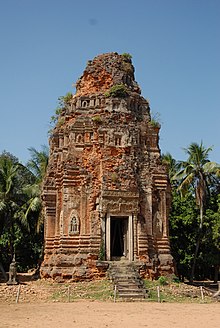Lolei
| Lolei | |
|---|---|
 | |
| Religion | |
| Affiliation | Hinduism |
| Deity | Shiva |
| Location | |
| Location | Roluos,Siem Reap |
| Country | Cambodia |
| Geographic coordinates | 13°21′10″N103°58′26″E/ 13.35278°N 103.97389°E |
| Architecture | |
| Type | Khmer(Preah KotoBakhengstyle) |
| Creator | Yasovarman I |
| Completed | 893 A.D. |
Lolei(Khmer:ប្រាសាទលលៃ) is the northernmost temple of theRoluos groupof three late 9th centuryHindutemples atAngkor,Cambodia,the others members of which arePreah Koand theBakong.Lolei was the last of the three temples to be built as part of the city ofHariharalayathat once flourished at Roluos, and in 893 theKhmerkingYasovarman Idedicated it toShivaand members of the royal family. The name "Lolei" is thought to be a modern corruption of the ancient name "Hariharalaya,"[1]: 98, 112 which means "the city ofHarihara."Once an island temple, Lolei was located on an island slightly north of the centre in the now dry Indratatakabaray,[2]: 60 construction of which had nearly been completed under Yasovarman's father and predecessorIndravarman I.Scholars believe that placing the temple on an island in the middle of a body of water served to identify it symbolically withMount Meru,home of the gods, which inHindumythology is surrounded by the world oceans.[3]
Site
[edit]
Lolei consists of four brick temple towers grouped together on a terrace. The king built Lolei for his ancestors. One for his grandfather, one for his grandmother, one for his father, and one for his mother. The two front towers are for the males while the two towers at the back are for the females. The two taller towers are for his grandparents while the two shorter towers are for his parents. Originally, the towers were enclosed by an outer wall access through which was through a gopura, but neither wall nor gopura has survived to the present. Today, the temple is next to a monastery, just as in the 9th century it was next to anashrama.[4]
The temple towers are known for their decorative elements, including theirfalse doors,their carvedlintels,and their carveddevatasanddvarapalaswhich flank both real and false doors. Some of the motifs represented in the lintels and other sandstone carvings are the sky-godIndramounted on the elephantAiravata,serpent-like monsters calledmakaras,and multi-headednagas.
Footnotes
[edit]- ^Coedès, George(1968). Walter F. Vella (ed.).The Indianized States of Southeast Asia.trans.Susan Brown Cowing. University of Hawaii Press.ISBN978-0-8248-0368-1.
- ^Higham, C., 2001, The Civilization of Angkor, London: Weidenfeld & Nicolson,ISBN9781842125847
- ^Jessup, p.77; Freeman and Jacques, pp.202 ff.
- ^Freeman and Jacques, p.202.
References
[edit]- Michael Freeman and Claude Jacques,Ancient Angkor(Bangkok: River Books, 1999.)
- Helen Ibbetson Jessup,Art & Architecture of Cambodia(London: Thames & Hudson, 2004.)
See also
[edit]


